
James Ewell Brown "Jeb" Stuart was a Confederate States Army general during the American Civil War. He was known to his friends as "Jeb,” from the initials of his given names. Stuart was a cavalry commander known for his mastery of reconnaissance and the use of cavalry in support of offensive operations. While he cultivated a cavalier image, his serious work made him the trusted eyes and ears of Robert E. Lee's army and inspired Southern morale.

George R. Crook was a career United States Army officer who served in the American Civil War and the Indian Wars. He is best known for commanding U.S. forces in the 1886 campaign that led to the defeat of the Apache leader Geronimo. As a result, the Apache nicknamed Crook Nantan Lupan, which means "Grey Wolf."

Ulzana's Raid is a 1972 American revisionist Western film starring Burt Lancaster, Richard Jaeckel, Bruce Davison and Joaquin Martinez. The film, which was filmed on location in Arizona, was directed by Robert Aldrich based on a script by Alan Sharp. It portrays a brutal raid by Chiricahua Apaches against European settlers in 1880s Arizona. The bleak and nihilistic tone of U.S. troops chasing an elusive merciless enemy has been seen as allegory to the United States participation in the Vietnam War.

William Edmondson "Grumble" Jones was a Confederate cavalry general with a reputation for being a martinet to his troopers and fractious toward superiors, but acknowledged to be a good commander. After disagreements of a personal nature with J.E.B. Stuart, Jones's brigade was set to guarding supply lines and unavailable during a crucial juncture of the Gettysburg Campaign when Lee suffered from a lack of capable reconnaissance cavalry. As the personality clash between Jones and Stuart escalated, Jones faced charges for impertinence, and was transferred to separate him from Stuart. Jones was killed leading a counter-attack in the 1864 Battle of Piedmont.
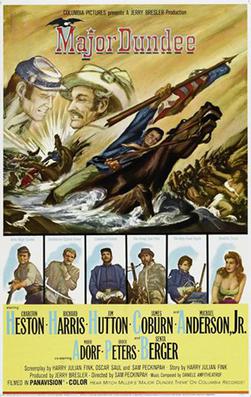
Major Dundee is a 1965 American Western film directed by Sam Peckinpah and starring Charlton Heston, Richard Harris, Jim Hutton, and James Coburn. Written by Harry Julian Fink, the film is about a Union cavalry officer who leads a contentious troop of Army regulars, Confederate prisoners, and Indian scouts on an expedition into Mexico during the American Civil War to destroy a band of Apaches who have been raiding United States bases and settlements in the New Mexico territory. Major Dundee was filmed in various locations in Mexico. The movie was filmed in Eastman Color by Pathécolor, print by Technicolor.

Virginia City is a 1940 American Western film directed by Michael Curtiz and starring Errol Flynn, Miriam Hopkins, Randolph Scott, and a mustachioed Humphrey Bogart in the role of the real-life outlaw John Murrell. Based on a screenplay by Robert Buckner, the film is about a Union officer who escapes from a Confederate prison and is sent to Virginia City from where his former prison commander is planning to send five million dollars in gold to Virginia to save the Confederacy. The film premiered in its namesake, Virginia City, Nevada. The film was shot in black and white (sepiatone).
The Starbuck Chronicles are a series of historical fiction novels by British author Bernard Cornwell set during the American Civil War. They follow the exploits of Boston-born Confederate officer Nathaniel Starbuck.

John Randolph Chambliss Jr. was a career military officer from Virginia who served in the Confederate States Army. He reached the rank of brigadier general of cavalry before being killed in action in August 1864 during the Second Battle of Deep Bottom. Born to a lawyer, Colonel and Mrs John Chambliss of Hicksford, Va, John, jr. graduated from West Point (1853) with several future generals; of particular note, his friend, David McM Gregg a future Union General as their paths would have an ominous crossing in August 1864.

The 1st West Virginia Cavalry Regiment served in the Union Army during the American Civil War. Although it started slowly, it became one of the most active and effective of the West Virginia Civil War regiments—and had 14 Medal of Honor recipients, the most for any West Virginia regiment during the war. It was originally called the 1st Virginia Cavalry, not to be confused with the Confederate 1st Virginia Cavalry. Some reports added "Union," "Loyal" or "West" when identifying this regiment. After the Unionist state of West Virginia was officially admitted to the Union in 1863, the regiment became the 1st West Virginia Cavalry Regiment. The National Park Service identifies it as the 1st Regiment, West Virginia Cavalry.

Two Flags West is a 1950 Western drama set during the American Civil War, directed by Robert Wise and starring Joseph Cotten, Jeff Chandler, Linda Darnell, and Cornel Wilde. The opening credits contain the following statement:
On December 8th, 1863, President Abraham Lincoln issued a Special Proclamation, whereby Confederate Prisoners of War might gain their freedom, provided they would join the Union Army to defend the frontier West against the Indians.
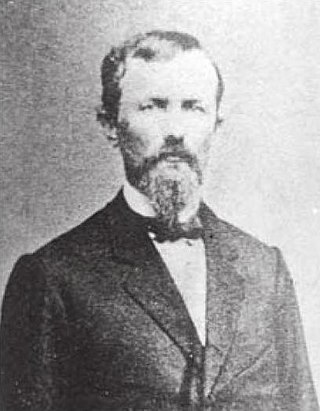
Benjamin Franklin "Grimes" Davis was an American military officer who served in Indian wars, and then led Union cavalry in the American Civil War before dying in combat. He led a daring escape from the Confederate-encircled Union garrison at Harpers Ferry.

John Pegram was a career soldier from Virginia who served as an officer in the United States Army and then as a brigadier general in the Confederate Army during the American Civil War. He became the first former U.S. Army officer to be captured in Confederate service in 1861 and was killed in action near the end of the war.
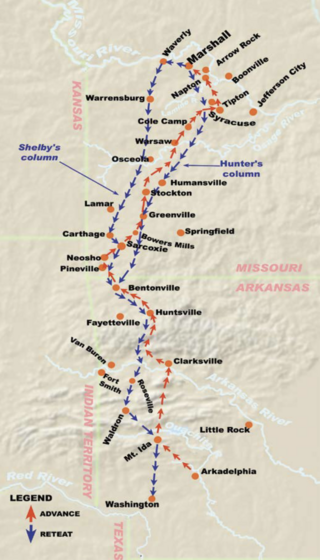
Shelby's Raid, also known as Shelby's Great Raid, was a Confederate cavalry incursion into Arkansas and Missouri during the American Civil War in 1863. Led by Colonel Joseph Orville Shelby, the raid took place from August 21, 1863, to November 3, 1863, covering over 800 miles across territories in west central and northwest Arkansas, as well as southwest and west central Missouri.

Rick Vallin was an actor who appeared in more than 150 films between 1938 and 1966.

Louis Henry Carpenter was a United States Army brigadier general and a recipient of the Medal of Honor for his actions in the American Indian Wars.
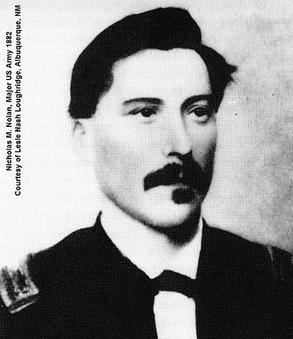
Nicholas Merritt Nolan was a United States Army major. An Irish immigrant, he began his military career in New York on December 9, 1852, with the 4th Artillery, and subsequently served in New York's 2nd Dragoons. He enlisted as a private and rose through the ranks becoming a first sergeant. He was commissioned an officer in late 1862 in the Regular Army, while serving with the 6th U.S. Cavalry Regiment during the American Civil War. He participated in 16 campaigns with the 6th and most of its battles. He was slightly wounded at the Battle of Fairfield and seriously wounded at the Battle of Dinwiddie Court House. He was brevetted twice and noted at least twice for gallantry during combat. He was slightly wounded when captured at the end of March 1865, and was later paroled. After the Civil War, he served with the 10th U.S. Cavalry, known as the Buffalo Soldiers, for 14 years. Nolan is also noted for his pluses and minuses during the Buffalo Soldier tragedy of 1877 that made headlines in the Eastern United States. He was the commanding officer of Henry O. Flipper in 1878, the first African American to graduate from the United States Military Academy at West Point. He commanded several frontier forts before his untimely death in 1883.
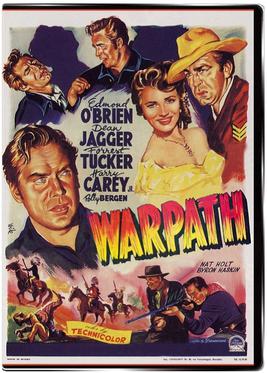
Warpath is a 1951 American Western film directed by Byron Haskin and starring Edmond O'Brien, Polly Bergen and Dean Jagger and Harry Carey Jr. The film was released as a Fawcett Comics Film #9 in August 1951.

The Cherry Creek campaign occurred in March 1890 and was one of the final conflicts between hostile Apaches and the United States Army. It began after a small group of Apaches killed a freight wagon operator, near the San Carlos Reservation, and was part of the larger Apache campaign, beginning in 1889, to round up Apaches who had left the reservations. The American army fought a skirmish with the Apaches near Globe, Arizona, at the mouth of Cherry Creek, which resulted in the deaths of two hostiles and the capture of the remaining three. Two men received the Medal of Honor for their service during the campaign.

The Battle of Fairfax Court House was fought during the Gettysburg Campaign of the American Civil War between two cavalry detachments from the Union Army of the Potomac, commanded by General Joseph Hooker, and the Confederate Army of Northern Virginia, commanded by General Robert E. Lee.

"The Last Man" was an American television play broadcast live from CBS Television City in Hollywood on January 9, 1958, as part of the second season of the CBS television series Playhouse 90. Aaron Spelling wrote the teleplay, John Frankenheimer directed, and Paul Newman hosted. Sterling Hayden, Carolyn Jones, and Wallace Ford starred. It was later made into a feature film, One Foot in Hell.



















